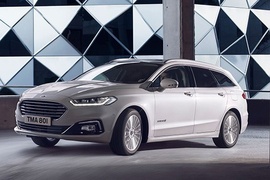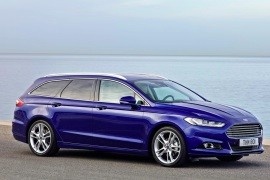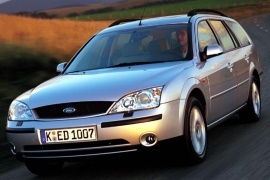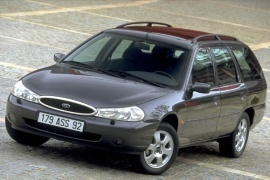
FORD Mondeo Wagon
Generations Timeline, Specs and Pictures

The Ford Mondeo was introduced to the market in 1993 and it was produced ever since.
In 2014 it reached its fourth generation, but it had to be refreshed due to European regulations.
The fourth generation of the Mondeo received an ample facelift in 2019. It wasn’t only for the looks but for the technological part as well. Due to its cavernous trunk space, the station-wagon version was one of the roomiest cars in its class.
The exterior of the car featured a new trapezoidal grille shape with a 3D effect. For the Titanium trim levels, it featured horizontal chrome slats. The lower apron featured a new grille as well and new fog lights. For the ST version, smaller winglets were added on the sides. In the back, the C-shaped taillights were intersected by a stylish, trim in satin silver or chrome, depending on the car’s version.
Inside, the customers had a long options list to chose from and to select the interior’s look. From different trims to different infotainment systems and instrument cluster. The base version was fitted with a combination of analog and digital display. The seats were comfortable and also offered in a few upholstery and comfort levels, but the split-fold rear seats were fitted as standard.
Under the hood, the Mondeo station-wagon was offered with a wide choice of diesel, gasoline, and hybrid versions. Depending on the powering option, the car was fitted with a 6-speed manual, a CVT, or an 8-speed automatic. An all-wheel-drive version was on the list as well.

The station wagon market in Europe has two main contenders: the Volkswagen Passat and the Ford Mondeo.
Both are fighting for the supremacy in the medium-segment station wagon market. The Passat is ruling, but Ford is relentlessly charging. In 2015 it launched a new generation of the Mondeo Wagon (station-wagon) for the masses.
So, if someone will need a vehicle fit to carry big loads of furniture from the Ikea local store, they can choose the Mondeo Wagon. Its big tailgate, up to 1630 liters (57.5 cu-ft) of trunk space and diesel engines makes it a good option. In some markets, it was offered even with a 1.0-liter EcoBoost engine. Manual transmission is available on the lower trim level.
Inside, the Mondeo features an infotainment system Sync 2 that works fine with both Android Auto and Apple CarPlay. The drivers are greeted with an LCD display and two dials or an optional 10” digital-analog instrument cluster.
Two important improvements were brought by the 2015 Mondeo: the hybrid powerplant and the AWD system. The hybrid system offers a mix made from a 2.0-liter Atkinson gasoline engine that offers 140 hp, plus an electric motor of 120 hp. It is mated to a CVT gearbox.
The AWD version is available with an intelligent system that varies the torque distribution between the axles. The engine offered for these variants was a 2.0-liter TDCI unit that offers 210 hp, mated to a dual-clutch 8-speed gearbox.

The third generation of the Mondeo was introduced at the 2007 Geneva Motor Show and previewed as a hatchback in the 007 James Bond film, Casino Royale.
The Mondeo was built on the same platform as the Mazda 6/Atenza, and it was not sold in the U.S., like the first generation where the Fusion model filled that segment. The vehicle was available as a four-door sedan, five-door hatchback, and a station-wagon. The hatchback was the first to be unveiled.
Featuring a new design language, named kinetic-design, the Mondeo represented Ford’s biggest car on the European market. Its front grille left the rounded sides of the trapezoidal shape from its predecessor and adopted sharper, straight lines. On the other hand, the headlights were swept on the sides, with a bigger interior side. A wider lower grille was installed on the apron. The station wagon version featured a longer roofline and, in the back, vertically mounted taillights.
Inside, the Mondeo offered a roomy interior due to its long, 2.85 m (112.2 in) wheelbase. The designers installed a new dashboard with two analog dials and a central TFT screen. For the infotainment system, Ford installed a new unit that included Bluetooth connectivity and sat-nav in the top-spec version. In terms of practicality, the Mondeo Station wagon offered even more interior room than its predecessor. It reached 1728 liters (61 cu-ft) with the rear seats folded.
Under the hood, Ford installed a wide choice of gasoline or diesel engines. They ranged from a mere 1.6-liter 115 hp turbodiesel up to a 2.0-liter turbocharged gasoline unit that offered 240 hp. Most versions were mated to a 6-speed manual, while a 6-speed automatic was on the options list.

While Ford was preparing the launch of the third generation of the Mondeo, its marketing department thought that the wagon still had something to say.
It was one of the largest vehicles in its class, and the cavernous trunk was good to move a student from home to college into one trip without the need of a trailer attached. The big station-wagon was designed to fill the needs of a family who didn’t want an MPV. With its rear seats folded, it was good enough as a sleeping place.
With its triangular headlights swept over the hood and the slim curved trapezoidal grille, the Mondeo’s second generation was a hit. It was introduced to the market in 2000, but its design was not outdated. Still, Ford decided to do a facelift on it and slightly changed the front bumper and the headlights.
The interior was good looking with a dashboard that offered the same two big dials for the tachometer and speedometer and two small LCD displays on the bottom of them. A nice touch of luxury feel was the oval clock on the center stack, above the optional infotainment system, which featured a CD and sat-nav. Since the Mondeo was well known for its speed cornering abilities, the carmaker decided to install higher bolstering on the front seats, to keep the occupants in place. In the back, the split-folding seatback allowed the trunk to be expanded to 1700 liters (60 cu-ft) from a decent 538 liters (19 cu-ft).
The 2005 model received a new engine lineup, including the Duratorq diesel engines offered in four different power outputs.

The Mondeo MKII station-wagon was highly appreciated by its customers due to its big trunk space.
It received the first facelift in 2003, along with the rest of the range.
While it was still a market leader in some countries, the Mondeo MKII received an update in the summer of 2003. The carmaker introduced new features and a few changes to the interior. The change was not necessary for the drivetrain since the following pollution norms were introduced in 2005 when Ford launched the second facelift for a car that lasted only seven years on the market.
From the outside, the only noticeable change was for the grille, which featured a chrome surrounding and a honeycomb mesh grille. The bumper was enhanced as well, with the introduction of larger fog-lights in different casings. On the sides, the turn-signals that were mounted on the fenders were transparent instead of orange. After the B-pillar, the Mondeo Wagon featured a longer roof to accommodate the bigger trunk space. It measured 540 liters (19 cu-ft) with all the seats up, while with the rear seats folded, it reached up to 1700 liters (60 cu-ft).
Inside, Ford enhanced or changed some parts to improve the car’s quality. For instance, it signed a deal with Sony to provide the CD-radio unit, which was much better integrated into the center stack. Other buttons and switches received an improved design.
For the engine lineup, Ford introduced a 3.0-liter gasoline V6 unit for the top version. Since the European diesel market was increasing and became very attractive for fleets, the blue-oval brand enhanced the 2.0-liter TDCI unit to produce 155 hp instead, 25 hp more than its predecessor.

The second generation of the Mondeo Wagon appeared on the market in 2000, and it offered one of the biggest trunks in its car-segment.
Soon after its introduction, the Mondeo became a market leader in several countries. Its new design was far away from its predecessor. It was a completely new design concept, named “New Edge Design.” But Ford had to make some sacrifices and improved the car twice: in 2003 and 2005.
On the outside, the Mondeo Wagon featured a mesh-grille at the front and triangular, swept-back headlights. A two-slats lower grille was installed in the lower bumper area. Depending on the trim selected, Ford installed fog-lights in the front bumper. After the B-pillar, the Mondeo Wagon featured a longer roof to accommodate the bigger trunk space. It measured 540 liters (19 cu-ft) with all the seats up, while with the rear seats folded, it reached up to 1700 liters (60 cu-ft).
Even though the Mondeo was considered the flagship for the European market, Ford didn’t try to make it look different. It featured a sound system with a cassette player and a simple radio function. The buttons’ design was clearly way under the car’s target.
Ford installed a very wide choice of engines, both gasoline, and diesel-powered. For selected versions, the carmaker offered an automatic transmission.

The first generation of the Mondeo was introduced in 1993 and soon after the customers started to complain about it.
Ford offered a fix for those with the introduction of the 1996 version.
The Mondeo was a billion-dollar car investment, and Ford didn’t want to lose the hype that joined the launch of their latest sedan. It was a revolutionary vehicle, which replaced the RWD Sierra with the new FWD vehicle. Like the Sierra, the Mondeo was offered in a few body versions: sedan, hatchback, and station wagon.
The 1996 Mondeo kept only about 35% parts from the 1993 model. The bigger headlights solved the night visibility problem. Due to that, the hood, the front fenders, and the bumper had to be changed. Faced with that dilemma, Ford continued to change other panels of the car. Only the basic structure and the rear quarter panels remained the same. At the back, the designers installed new taillights to fit the design language that came with the headlights.
The interior was slightly changed to offer better legroom for the rear seat passengers. The headroom was no longer a problem with the wagon version due to the long roof. A split-folding rear seat backrest was fitted as standard to expand the trunk space.
Under the hood, Ford installed a choice of diesel and gasoline engines. The base model was fitted with a 1.6-liter four-cylinder, while the top versions featured a 2.5-liter V6. All versions were paired to a standard 5-speed manual transmission, while a 4-speed automatic was available for selected engines.

Ford invested one billion dollars in the Mondeo project, but the result was a global car available in three shapes: sedan, hatchback, and station wagon.
The mid-size vehicle segment was changing, and Ford understood that it had to develop new ideas. First of all, it created an entirely new platform and switched from the rear-wheel-drive Sierra to the front-wheel-drive Mondeo. So, it made the mid-size vehicle a world car, but some versions didn’t go to all the markets, such as the station-wagon.
With its curved lines and slim headlights, the Mondeo was a revolutionary thinking vehicle for the blue-oval brand. That allowed them to minimize the grille, sharpen the front end of the car, and lower the aerodynamic drag coefficient. Unlike the Sierra, the new mid-size vehicle came with rounded body panels and smoother corners. The station-wagon featured a longer roof to accommodate the extra trunk area. Its volume ranged between 650 l (22.3 cu-ft) and 900 l (31.8 cu-ft).
Inside, the designers continued the exterior’s rounded shapes with smooth and curved lines on the dashboard. The driver-oriented center stack was built as a natural extension of the instrument cluster. Between the front seats, the designers installed an armrest with a storage compartment. For the hatchback, the rear bench featured a split-folding seatback to increase the luggage compartment. Ford offered the Mondeo with a cloth or leather upholstery, depending on the trim-level.
Under the hood, the car featured a wide choice of engines, both diesel and gasoline. A 1.6-liter powered the entry-level while the top version was a 2.5-liter V6. The standard transmission for the entire range was a 5-speed manual, and a 4-speed automatic was available for selected engines.























































